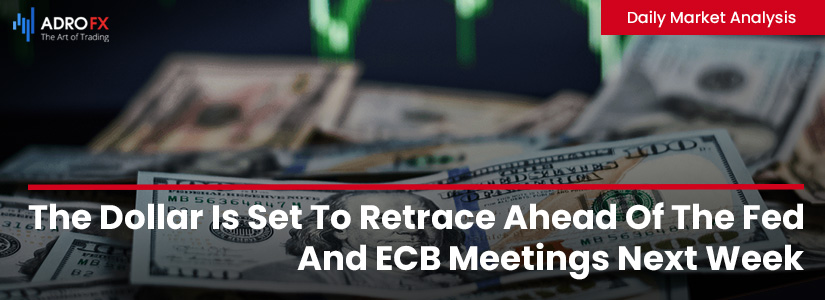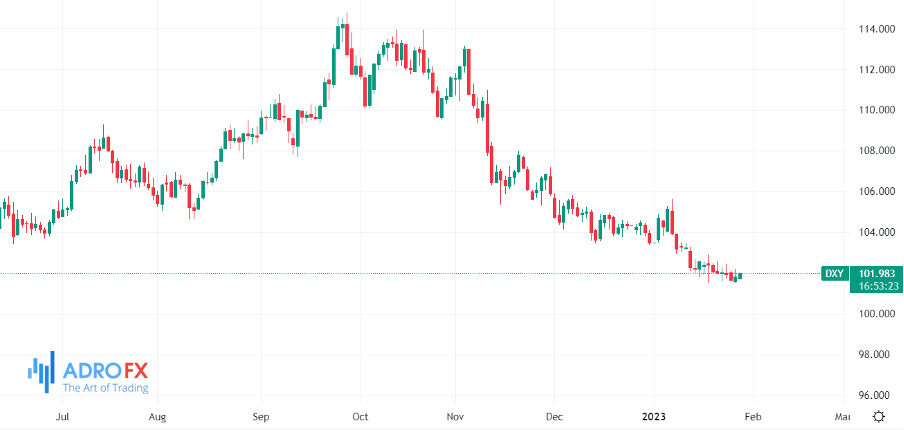The Dollar Is Set To Retrace Ahead Of The Fed And ECB Meetings Next Week | Daily Market

Key events:
- Eurozone - ECB President Lagarde Speaks
- USA - Core PCE Price Index (MoM) (Dec)
- USA - Pending Home Sales (MoM) (Dec)
The dollar gained against all currencies of the Big Ten yesterday amid the published economic data. The strengthening of the dollar coincided with the growth of risk appetite in Europe and the U.S. In this case, the yield on 2-year U.S. Treasury notes interrupted a two-day decline and rose Thursday to 4.18%, and the yield on 10-year bonds rose 5 bps to 3.49%.

The U.S. economy beat expectations for Q4 2022 GDP, according to a preliminary estimate, grew 2.9% y/y in Q4 (consensus forecast 2.6% y/y) compared to 3.2% y/y growth in Q3. Meanwhile, initial claims for unemployment benefits in the week through Jan. 21 unexpectedly declined to 186,000 claims, the lowest weekly figure since April 2022. Durable goods orders in December and new home sales also beat estimates. The numbers point to a still robust economy, not an economy on the brink of recession. Despite the Fed's extremely aggressive rate hike cycle implemented last year, there is still a chance for a "soft landing," figures released Thursday indicate. That raises the possibility of a scenario in which tight monetary policy cuts household spending and reduces inflationary pressures, but the accompanying economic slowdown is not significant enough to cause a surge in unemployment.

This is not without a fly in the ointment, however. The U.S. economy is driven by consumer demand. The pace of growth in the personal consumption indicator slowed to 2.1% in Q4, down from 2.3% in Q3 and a forecast of 2.9%. As a result, a closer look at the GDP data reveals that strong consumer spending in the service sector led to solid growth in the U.S. economy in Q4 2022. However, consumer demand is losing its momentum, so we maintain our view that the U.S. economy is headed for a moderate (mild) recession in 2023. The market remains confident that the Fed will raise the federal funds rate 25 bps to the 4.5-4.75% APR range on February 1. Whether or not there will be a 25bp hike in March. (the market now estimates such a move with an 85% probability) is less important than whether the Fed will keep the rate at its peak throughout 2023 or, as the market expects, cut it by 25bp or 50bp at the end of the year.

The focus of next week's Fed and ECB meetings. The Fed is widely expected to raise rates by 25 bps next week on Wednesday. At the same time, the ECB has virtually guaranteed that next Thursday, February 2, the deposit rate will be raised by 50 bps. As these events have already been taken into account by the market and the further prospects are covered by the fog of uncertainty, we might see some technical upward correction of the dollar due to the partial profit taking in the short positions in the American currency before February 1 and 2. The key question is whether the Fed will give a signal to expect another 25bp rate hike in March. Similarly, an equally important question is whether the ECB will signal another 50bp rate hike in March or hint at lowering the step to 25bp. The swap market is 100% unsure right now that the Fed will take a pause from March and the ECB will move to a +0.25% step. If that outcome becomes more likely, the dollar index could be below 100 points for the first time since April 2022 and the EUR/USD could attack the 1.10 psychological level.










